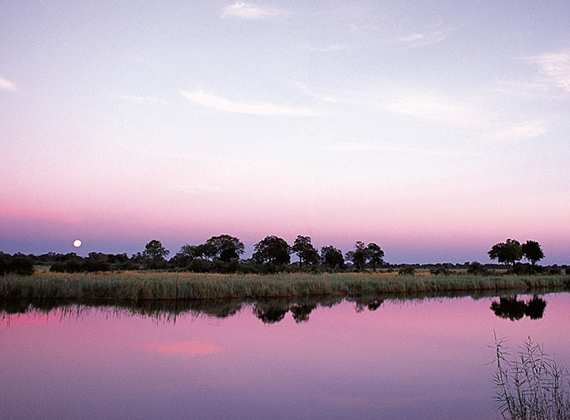(Map of Namibia, where the current study was conducted. The long, thin strip between Zambia and Botswana is the Caprivi region.)
In order to investigate the presence and potential impacts of gender differences related to conservation, two researchers from Michigan State University recently studied male and female residents of Namibia's Caprivi region. There, livelihoods are dependent on natural resources that are often threatened by the region's multitude of wildlife, which are thought to cause as much as $770,000 in damage each year to livestock and crops. This human-wildlife conflict (HWC) was the main focus of the current study, as it is important not just in Namibia, but around the world; HWC has been associated with hardships for both humans (e.g., property damage, injury, death) and animals (e.g., death, reduction in habitat, extinction).
The researchers used two techniques, focus groups and interviews, to document gender differences in wildlife-related risk perception. Participants in the focus groups were asked to list risks associated with two topics: wildlife and local livelihoods. They were then asked to decide which risks were related to HWC and to discuss their results as a group. Interviews were used to gain more detailed information about attitudes toward the interface between HWC and risks to wildlife/livelihoods, factors influencing risk perception, HWC-related vulnerability, and adherence to wildlife laws.
(Sunset in Namibia's Caprivi region)
Concept maps were used to visualize patterns and explore gender differences. First, the researchers looked for "overarching risk themes" that were common across all the focus group risk lists. They then identified "theme attributes" and "descriptions of the attributes." To explain this system of classification, the authors use the example of "lack of access to education," one of the risk themes they identified. One attribute of this theme is "lack of family planning," while a description of the theme is "increased population." Only once these were identified for all major themes did the researchers "gender disaggregate" the data in order to look for differences between the sexes. Concept mapping allowed them to see where men and women overlapped, and where they differed. A separate map was created for each of three HWC-related "dimensions": people, wildlife, and habitat.
Overall, women identified more risks than men did; 81 were related to the wildlife topic (vs. 70 for men), and 99 were related to the livelihood topic (vs. 65 for men). Gender similarities and differences varied depending on both topic and dimension. For instance, in the people dimension of the "local livelihoods" topic, women named a broad range of risks, while men provided more detail on a smaller number; one example is "infrastructure," which was named by both men and women but further defined only by men to include roads, buildings, schools, and clinics. Although both groups frequently overlapped when providing lists of things--such as dangerous animals or activities that cause wildlife-disrupting noise pollution--one group often gave more examples than another. Both sexes, for instance, listed buffaloes, elephants, hyenas, lions, and porcupines as dangerous animals, but only men added hippos and crocodiles to that list. There were also cases where one gender thought of issues or relationships not mentioned by the other. For example, only women emphasized a relationship between wildlife and disease transmission, but only men discussed the importance of resource competition between wildlife and livestock. Other topic-dimension combinations, such as the habitat dimension of the "wildlife" topic, produced very similar responses from people of both genders. Similarly, results of the interviews suggested that both males and females had similar risk perceptions associated with human-wildlife conflict, though women were significantly more likely to be "highly worried" about the potential impacts of HWC on local livelihoods.
(Spotted hyena, one of the focal species of the Caprivi Carnivore Project, which aims to reduce carnivore-related HWC in the Caprivi region)
The combination of gender similarities and differences documented here suggests that men and women may complement each other nicely when it comes to thinking about conservation issues related to human-wildlife conflict. At the same time, the presence of gender-specific ideas and attitudes indicates that conservationists should try to avoid a "one-size-fits-all" approach to designing, and drumming up support for, new management plans. For instance, men and women in the current study both acknowledged the need for wildlife deterrents. However, women see some deterrents as a source of risk to wildlife and therefore may not support the use of these devices. In situations such as this, alternative techniques could be suggested, or conservationists might provide evidence indicating that there is no need to worry about the desired method. Either way, knowledge of the gender difference could ultimately make the mitigation plan more effective by rendering it more widely attractive throughout the community; over the long run, this could save considerable money, time, and effort.
The researchers also point out the opportunity to combine both men's and women's concerns in order to achieve different goals simultaneously. As an example, they cite the use of fences, which can be used to both reduce disease transmission (a concern of women) and diminish resource competition between wildlife and domestic stock (a concern of men). Techniques such as this allow "knowledge about gender [to be] leveraged to explicitly craft and assess interventions that more purposefully respond to the needs and perceptions of different groups." This, the researchers hope, will allow conservationists to think of gender not merely "as an explanatory variable for understanding how different groups think about conservation issues," but as an opportunity to reduce human-wildlife conflict by improving management plans.
---
Gore, M.L. and Kahler, J.S. 2012. Gendered risk perceptions associated with human-wildlife conflict: implications for participatory conservation. PLoS ONE 7(3):e32901.
Thanks to the following websites for providing the images used in this post:
http://www.thecommonwealth.org/YearbookHomeInternal/138838/
http://www.ganeandmarshall.com/destination/Namibia/Caprivi-.html
http://www.predatorconservation.com/caprivi_carnivore_project.htm



I really enjoyed reading your article. I found this as an informative and interesting post, so i think it is very useful and knowledgeable. I would like to thank you for the effort you have made in writing this article.
ReplyDeletesextoys jakarta